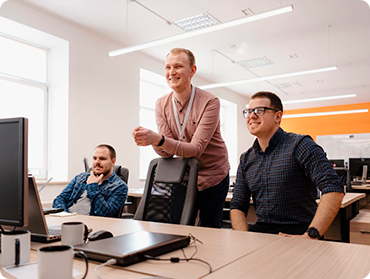Project Case Study: Software and New Architecture Development for client Enterprises
Project Overview
Client Enterprises, a leading retail company, recognized the need to upgrade its legacy software system and develop a new, robust architecture to support its expanding operations and improve customer experience. The company aimed to modernize its IT infrastructure, enhance system performance, and facilitate future scalability. Our IT company was engaged to design and implement the new software and architecture, ensuring a seamless transition and substantial improvements in efficiency and functionality.
Project Objectives
- Modernize Software Systems: Replace legacy software with a modern, scalable solution.
- Enhance Performance and Efficiency: Improve the speed, reliability, and efficiency of business processes.
- Facilitate Scalability: Design an architecture that can scale to meet future growth and evolving business needs.
- Improve User Experience: Enhance the user interface and user experience for both employees and customers.
- Ensure Security and Compliance: Implement robust security measures and ensure compliance with industry standards.
Project Phases
Phase 1: Requirements Gathering and Planning
1. Stakeholder Engagement
- Conducted workshops and interviews with key stakeholders, including management, IT staff, and end-users, to understand their requirements and pain points.
- Documented business processes and identified critical functionalities required in the new system.
2. Current System Assessment
- Evaluated the existing legacy software and architecture to understand its limitations and integration points.
- Identified data migration needs and potential risks associated with the transition.
3. Project Planning
- Developed a detailed project plan outlining timelines, resources, milestones, and risk management strategies.
- Established a cross-functional project team, including software developers, architects, business analysts, and quality assurance specialists.
Phase 2: Architecture Design
1. System Architecture Design
- Designed a new architecture based on microservices, ensuring modularity, scalability, and ease of maintenance.
- Selected appropriate technology stack, including cloud infrastructure (e.g., AWS, Azure), databases (e.g., PostgreSQL, MongoDB), and development frameworks (e.g., Spring Boot, Angular).
2. Integration Strategy
- Developed an integration strategy to ensure seamless communication between the new system and existing applications, including ERP, CRM, and inventory management systems.
- Utilized APIs and middleware to facilitate data exchange and interoperability.
3. Security and Compliance
- Implemented robust security measures, including encryption, access controls, and regular security audits.
- Ensured the new architecture complies with relevant regulations (e.g., GDPR, PCI DSS) and internal security policies.
Phase 3: Software Development
1. Agile Development Approach
- Adopted an Agile methodology to ensure iterative development, continuous feedback, and flexibility in responding to changing requirements.
- Conducted sprint planning, daily stand-ups, and sprint reviews to keep the project on track and stakeholders informed.
2. Core Functionality Development
- Developed key modules of the new software, including user management, inventory control, order processing, and customer relationship management.
- Focused on building a user-friendly interface with responsive design to enhance the user experience for both desktop and mobile users.
3. Data Migration
- Developed a comprehensive data migration plan to transfer data from legacy systems to the new architecture with minimal disruption.
- Conducted thorough testing to ensure data integrity and consistency during and after the migration process.
Phase 4: Testing and Quality Assurance
1. Automated and Manual Testing
- Implemented a combination of automated testing (unit tests, integration tests) and manual testing (user acceptance testing) to ensure the system’s reliability and performance.
- Conducted load testing to validate the system’s scalability and identify any performance bottlenecks.
2. User Acceptance Testing (UAT)
- Involved end-users in the testing process to validate that the new software meets their needs and expectations.
- Gathered feedback and made necessary adjustments to improve usability and functionality.
Phase 5: Deployment and Training
1. Deployment Planning
- Developed a detailed deployment plan to ensure a smooth transition from the legacy system to the new architecture.
- Scheduled the deployment during non-peak hours to minimize business disruption.
2. Employee Training
- Conducted training sessions for employees to familiarize them with the new system and its features.
- Provided comprehensive user manuals and support resources to aid in the transition.
3. Post-Deployment Support
- Offered ongoing support to address any issues and ensure the system’s stability and performance.
- Conducted regular system reviews and performance monitoring to identify areas for further improvement.
Project Outcomes
1. Modernized IT Infrastructure
- Successfully replaced the legacy system with a modern, scalable architecture that supports client Enterprises’ current and future needs.
2. Improved Performance and Efficiency
- Enhanced system performance, resulting in faster processing times, reduced downtime, and increased operational efficiency.
3. Enhanced User Experience
- Delivered a user-friendly interface that improved employee productivity and customer satisfaction.
4. Scalability and Flexibility
- Implemented a scalable architecture that allows for easy expansion and adaptation to changing business requirements.
5. Robust Security and Compliance
- Ensured the new system adheres to industry security standards and regulatory requirements, protecting sensitive data and minimizing risk.
Conclusion
The software and new architecture development project for client Enterprises successfully modernized their IT infrastructure, delivering significant improvements in performance, scalability, and user experience. By leveraging our expertise in software development and architecture design, client Enterprises is now well-positioned to achieve its business goals and drive long-term growth. Our comprehensive approach to planning, development, and support ensured a seamless transition and substantial benefits for the company.
